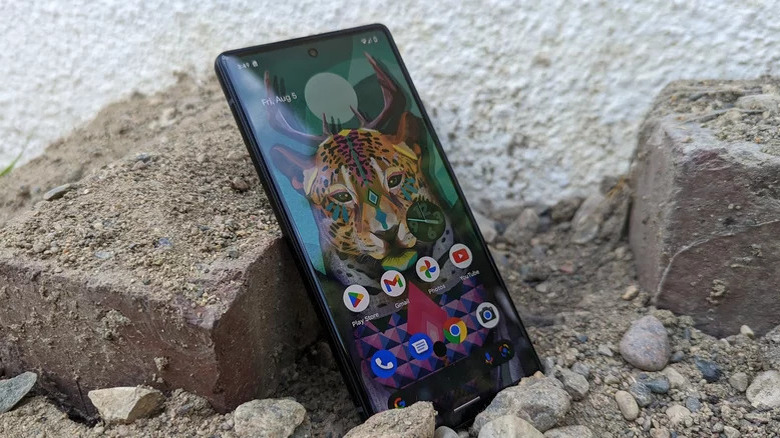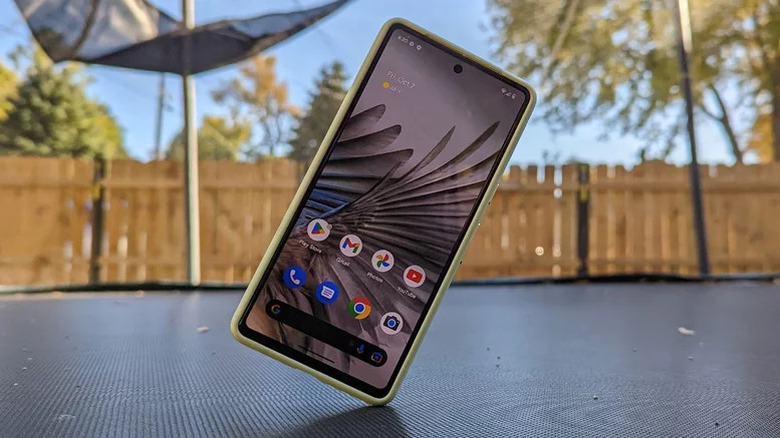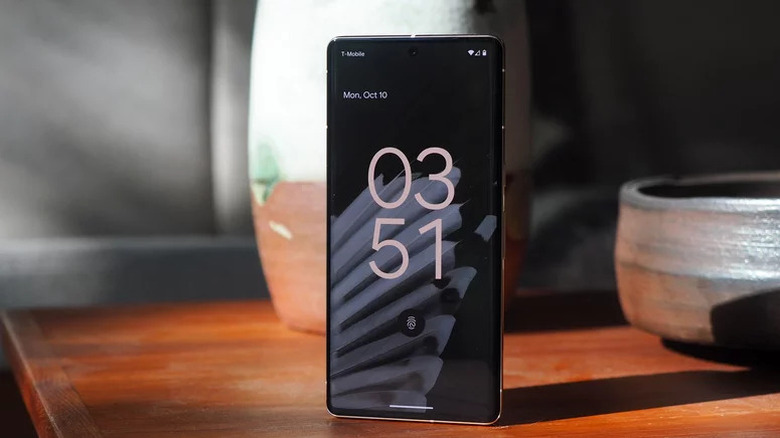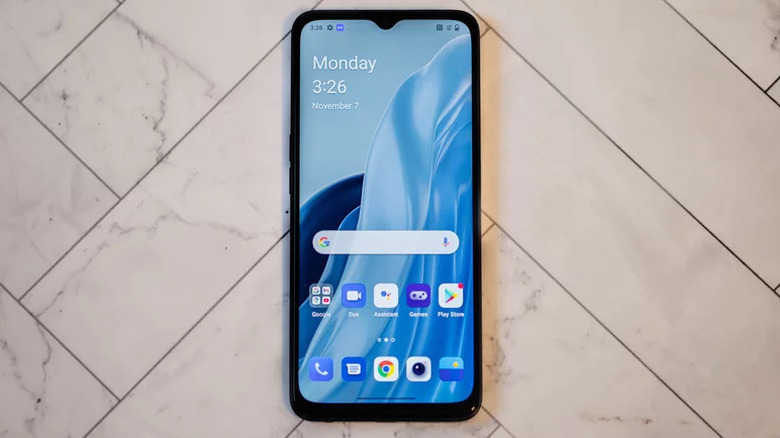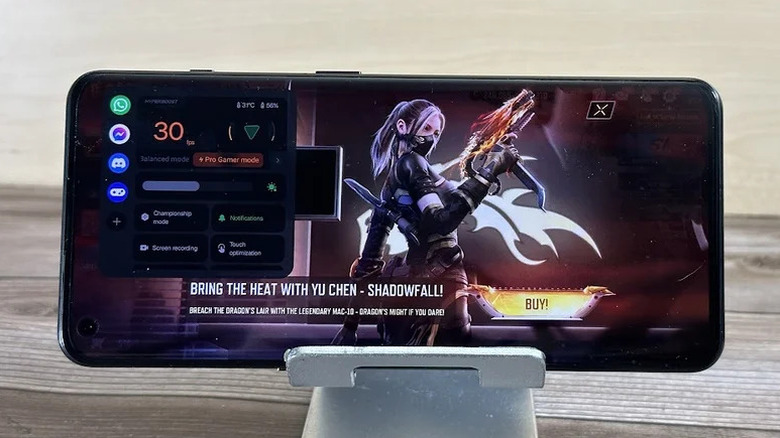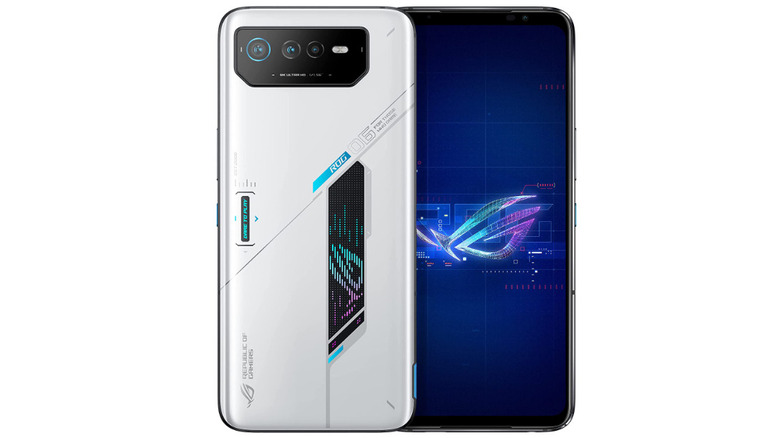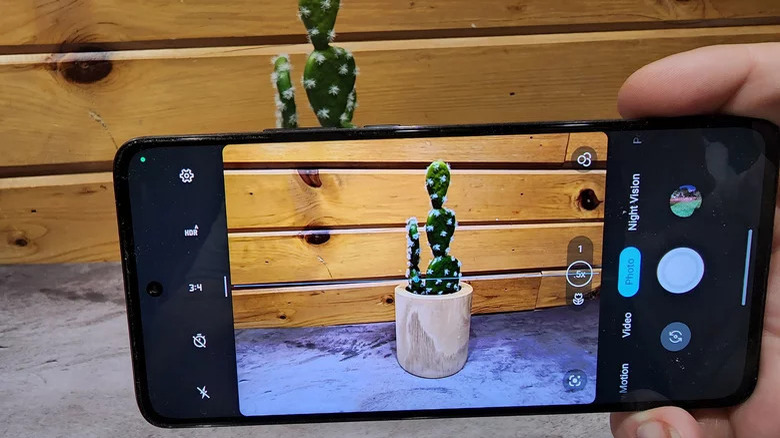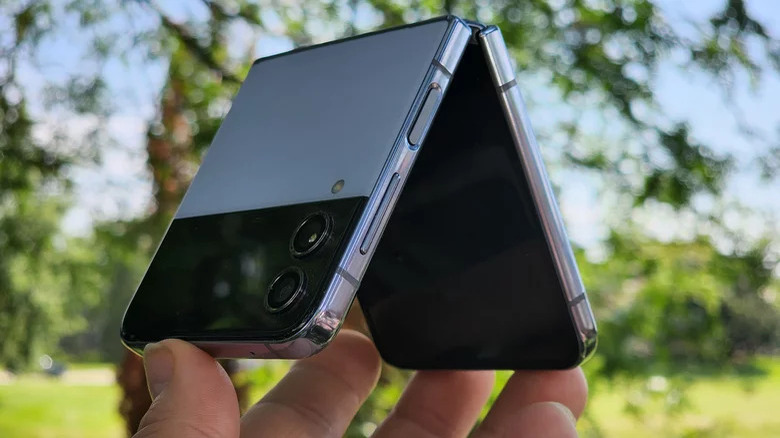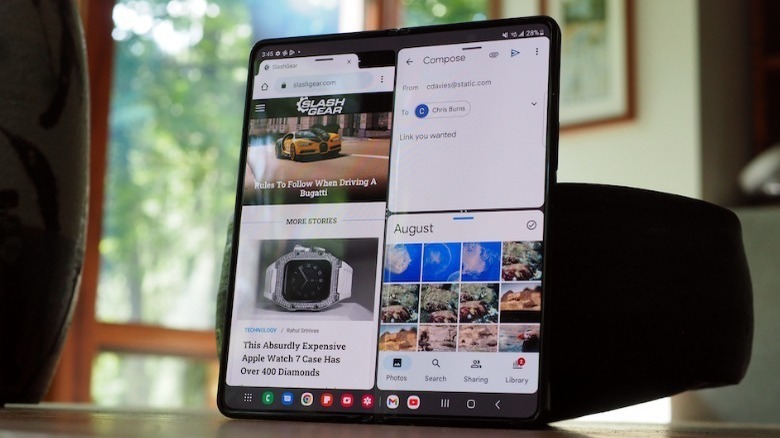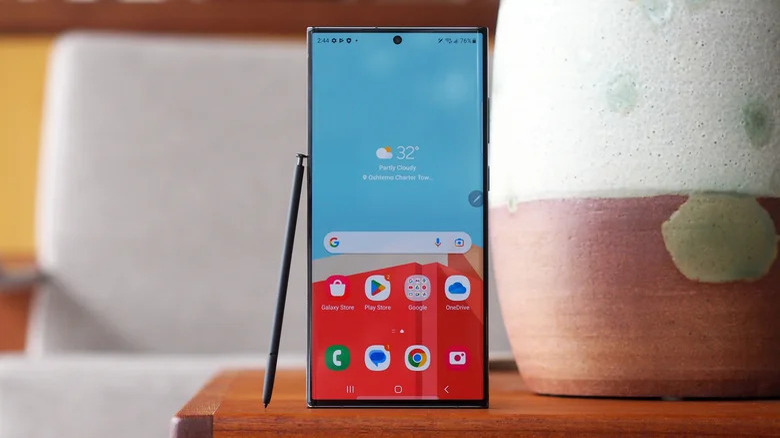Smartphones To Buy If You're Tired Of Apple
We may receive a commission on purchases made from links.
For years, Apple has dominated the smartphone market with its sleek designs, snappy performance, and friendly user interface. In spite of this, the iPhone manufacturer is by no means perfect, a steep retail price and closed ecosystem have left many people frustrated with a pattern that barely changes. Therefore, if you're tired of Apple, you might want to consider an alternative smartphone manufacturer that can potentially open a world of possibilities.
Google, OnePlus, Samsung, ASUS, and Motorola offer a wide range of devices with innovative features that can rival the Apple giant. From gorgeous 165 Hz refresh rates to 200 MP cameras, there's never been a better time to break away from Apple's hold. To that end, we take a look at the best smartphones to buy if you're looking for a change. These include affordable base models that offer serious value for money, to flagship series that go head-to-head with the iPhone 14 Pro. Without any further ado, here's what all the Android fuss is about!
Google Pixel 6a
While Apple iPhones tend to be lavish in price, the Google Pixel 6a offers impressive features at just $299. Available in Sage, Chalk, and Charcoal, the Pixel 6a is ready to impress with its 6.1-inch FHD OLED display that emits crisp visuals that are warm and colorful.
Some of the standout specifications include 128GB of storage, 6GB of RAM, and a dual rear camera system. The dual rear camera has a 12.2 MP wide lens and a 12 MP ultrawide lens that can capture detailed photos during the day, and vibrant pictures in the evening using Night Sight. Additionally, there's a front-facing 8 MP camera, and video quality can go as high as 1080p at 240 fps to 4K at 60 fps.
Under the hood, the Pixel 6a runs on the Google Tensor processor, which is a custom chip that is not only fast but also intelligent. Using machine learning, the Pixel 6a can learn your habits, swiftly respond to your needs, translate languages in real time, and save power for improved battery life. The Pixel 6a should therefore have no problem getting you through the day on a single charge, as the adaptive system powers your favorite apps while closing the ones you rarely use.
Extra features worth noting are the inclusion of both a fingerprint unlock option and the built-in Titan M2 chip which add an extra layer of security. The Google 6a also supports 5G and comes with an IP67 rating so you can take it practically anywhere. If you're on a budget, the Google Pixel 6a should be a serious consideration.
Google Pixel 7
There's no doubt that the Google Pixel 6a was one of the best budget smartphones released in late 2022. It gave users the Google Pixel experience at an affordable price but sacrificed a few key features that would have made it a premium Android contender. The Google Pixel 7 is a beefier version at $599 but with a lot more upgrades and performance on offer.
Starting with the build quality, the Google Pixel 7 is equipped with a matte aluminum frame and an IP68 rating for both dust and water resistance. The exterior is tough, while also having the ability to fully submerge under water for up to 1.5 meters for 30 minutes. The OLED display is a good size at 6.3 inches, but this time featuring a 90 Hz display when compared to the 6a's 60 Hz. The display panel quality should therefore not only be crisp and clear but smoother and highly responsive.
The key difference between the Google Pixel 6a and 7 however is camera quality. The Google Pixel 7 has the same dual camera setup but uses a 50 MP main lens, and a 12 MP ultrawide lens. Photos are color accurate and sharp while bordering professional photography owing to the newer Google Tensor G2 chipset. For example, the Google Unblur system lets you sharpen and refine snapshots after your photoshoot. Even more impressive, is the camera's ability to distinguish the edges of objects, allowing it to remain in focus and capture extreme detail up close.
Sold in both a 128GB and 256GB version, with 5G connectivity and wireless charging, the Google Pixel 7 punches way above its weight. The Pixel 7 delivers a premium Android experience.
Google Pixel 7 Pro
The Google Pixel 7 Pro is the enthusiast's choice. Starting at $770 for the 128GB version, the Pixel 7 Pro gives you more phone for your money. The 6.7-inch QHD OLED display is enormous in the palm of your hand, offering a buttery smooth experience thanks to the 120 Hz refresh rate. Not only is the screen sharper at 1440p, but also brighter at 1500 nits with an aspect ratio of 19.5:9.
The outlining feature, however, is the inclusion of three rear cameras. Similar to the dual rear camera setup of the Pixel 7, there is a 50 MP wide camera and a 12 MP ultrawide camera. The Pro version goes beyond this and adds a 48 MP telephoto lens that allows you to digitally zoom in further. To put this in perspective, the regular Pixel 7 has an 8x Super Res Zoom, while the Pixel 7 Pro offers 5x optical zoom in addition to 30x Super Res Zoom. Did we mention there's also an exclusive Macro Focus Mode that enhances close-up shots?
The camera isn't the only exciting feature of the Google Pixel 7 Pro though. Inside you'll find an extended 12GB of RAM and a 5000 mAh battery size. Google claims that you could get up to 72 hours of battery life using their Extreme Battery Saver mode, but for the most part, the Pixel 7 Pro should last you throughout an entire day. While some may lean towards the regular Pixel 7, if you prioritize screen size and camera functionality, the Pixel 7 Pro is a solid choice.
OnePlus Nord N300 5G
From its first impression, the OnePlus Nord N300 5G might not look like much with its giant chin bezel and waterdrop notch. As smartphones have continued to innovate in terms of appearance and build quality, these are characteristics that were filtered out years ago. The same goes for its box design that mimics the iPhone 13 series. Its plastic shell leaves you wanting more and removes any sense of premium build quality.
But, when reevaluating your expectations, and considering the Nord N300 is actually a sub $250 smartphone, there's a lot on offer here. The plastic shell is lightweight with a nice back texture that is grippy and comfortable within your hand. You'll find useful features such as a fingerprint scanner that doubles as a power button, a 3.5 mm headphone jack, and a memory expansion tray. Note that the N300 only comes in a 64GB version, so an SD card is a must.
The screen is a surprising 6.5-inch IPS 1080p 90 Hz display that is sharp and smooth without any pixel density issues. The 4GB of RAM and MediaTek chipset is also respectable and manages to run most of the popular apps and mobile games at an enjoyable level.
As for camera quality, you're looking at a 48 MP main camera and a 16 MP selfie camera. Again, it's nothing special, but the OnePlus processing software can dial up the contrast, enriching photos even against harsh backlighting. It's a pity the 1080p 30 fps video quality has no stabilization option, but at this price range, the Nord N300 is still a bargain.
OnePlus 11 5G
The OnePlus 11 5G is a premium smartphone that may fly under the radar for mobile enthusiasts. With its highly polished design and stunning features, you may be mistaken in thinking that the device looms around the Samsung S23 ultra price tag, but this is far from the truth. The OnePlus 11 is considerably cheaper at $699 for the 128GB version or $799 for the 256GB version, yet still manages to deliver a flagship experience.
In terms of size and appearance, the OnePlus 11 weighs around 205 grams and measures 8.5 mm in thickness. The phone isn't bulky by modern standards and maintains a good balance of luxury and comfort due to its aluminum chassis and rounded-edge design. The only drawback however is found on the back of the smartphone, where a few fingerprints may accumulate over time.
Moving onto raw performance, this is where the OnePlus 11 really shines. The screen is a 6.7-inch 2K "Super Fluid" AMOLED display backed by a variable refresh rate of up to 120 Hz. By virtue of the Qualcomm Snapdragon 8 Gen 2 chipset, the OnePlus 11 is also incredibly fast. Animations are instantaneous and there are no delays in general app use or heavier games such as "Call of Duty: Mobile."
As for photo quality, the OnePlus 11 consists of a triple-camera setup. There's a 50 MP main camera, which pulls in a lot of light, a 48 MP ultrawide lens that expands your field of view, and a 32-megapixel portrait telephoto sensor with 2x optical zoom. Therefore, at nearly $100 less than the Google Pixel Pro, the OnePlus 11 5G may just be a winner for those looking for a high-end display and multi-functional camera to match.
ASUS ROG Phone 6
Gaming phones aren't usually grouped with so-called flagship smartphones. They're often limited by their internal specifications, and neglect important aspects such as camera quality, software polish, and battery life. The ASUS ROG Phone 6 however, goes against the grain. ASUS has managed to create a flagship gaming smartphone with all the features you'd want in an everyday driver.
Upon first inspection, you'll notice that the ROG 6 is something otherworldly with its spaceship design and holographic ROG logo. The $899 phone is heavy at 239 grams with a 10.3 mm thickness but houses fantastic specs including, a Snapdragon 8+ Gen 1 chipset, 16GB of RAM, 512GB of storage, an IPX4 rating, two USB-C ports, and a 6000 mAh battery.
The 6.78-inch AMOLED screen is just as impressive, with a 2448 x 1080 resolution and a ridiculous 165 Hz refresh rate. Games are vibrant and viewing angles are exceptional. Titles such as "Genshin Impact" can run at 60 FPS on ultra-settings consistently. There's no stutter or crashes, while battery life only decreases by 15% for 30 minutes of playtime.
The included cameras are also surprisingly good for a gaming phone. At the back of the ROG 6, you'll find a 50 MP primary lens, a 13 MP ultrawide lens, and a 5 MP macro lens. It's not OnePlus 11 5G camera quality, but outdoor and low-light photos are still pretty good without over-saturation. There's even an option to record in 8K at 24 FPS!
The ROG 6 nails the hybrid gaming smartphone niche with exceptional system performance, both in-game and during everyday tasks. The power efficiency makes it an amazing option for those who find themselves alternating between their Nintendo Switch and iPhone.
Motorola Edge (2022)
The Moto Edge (2022) is an updated version of the 2021 Motorola Edge. The new release adds a few performance upgrades and is now more affordable at just $349. Launched as a midrange smartphone the Moto Edge seeks to compete against the likes of Apple's iPhone SE, or Samsungs Galaxy A53.
Starting at the front of the Moto Edge, you'll find that it is covered with Gorilla Glass 3, which can withstand light scratches and a fair amount of external pressure. Underneath lies the 6.6-inch FHD+ OLED panel that has a 144 Hz refresh rate. The phone carries an IP52 rating, so while dust and spills shouldn't be a problem, you can't go taking this one into the shower. With that said, the picture quality and smoothness of the display are impressive when compared to competitors in this price range.
Moving onto the back, the Moto Edge has another triple camera setup. There's a 50 MP main shooter, a 13 MP ultrawide lens, and a 2 MP depth sensor that helps with videos and portraits. While these specs may seem normal at first, Motorola has a few tricks up its sleeve as a result of a few software tweaks. Users can record videos in super slow motion at 960 frames per second, and dual capture for both front and rear reactions.
Battery-wise, the Moto Edge has a 5,000 mAh capacity, that while Motorola claims can last up to 2 days, leans more towards 1.5 days for regular users. In spite of this, there is 30W wired charging, 15W wireless charging, and even 5W reverse wireless charging. Bundling all the above features together, the Moto Edge is definitely an exciting mid-range experience offered at a budget price.
Samsung Galaxy Z Flip 4
Samsung's Galaxy Z Flip 4 combines the compact nature of the original 2000's flip phones to create a laptop-like smartphone that is perfect for YouTube, Skype calls, and video/picture capture. As a high-end Samsung device, the Galaxy Z Flip 4 starts at $899, and increases in price based on three sizing variations, namely the 128GB, 256GB, and 512GB storage capacities. While this may seem expensive at first, you're receiving a premium experience in return. The Flip 4 boats Samsung's Armor Aluminum frame, Gorilla Glass Victus Plus, a pre-installed screen protector, and an IPX8 water-resistant rating.
One of the coolest features of the Flip 4 is the customizable 1.9-inch cover display. It's perfect for checking notifications or controlling your media, while the phone is sealed and on standby. Once opened you'll find the main FHD 6.7-inch Super AMOLED display, which is supported by HDR10+. This is all bundled with a 120 Hz refresh rate, so everything remains fluid and smooth throughout.
As for performance the Galaxy Flip 4 includes 8GB of RAM and runs on the Snapdragon 8+ Gen 1 chipset. Tasks and commands are executed flawlessly, and you'll even be able to do a fair amount of gaming. Unfortunately, the 12 MP wide and ultrawide cameras on the Flip 4 aren't its strongest feature, but they should suit most people for everyday photography. You can, however, prop the phone up and shoot a 4K video hands-free courtesy of the 10 MP selfie cam, so influencers and streamers can go wild!
Samsung Galaxy Z Fold 4
The Samsung Galaxy Z Fold 4 is one of the most expensive smartphones out right now, starting at $1450. With this price, however, comes plenty of features, loads of innovation, and a tablet-like design that delivers a truly unique experience. As a foldable device, you're not only getting an incredible 7.6-inch 120 Hz AMOLED display inside but also a 6.2-inch 120 Hz AMOLED cover display that functions as a standard smartphone screen.
The Galaxy Z Fold 4 ships with One UI version 4.1.1 based on Android 12, though it has since been upgraded to Android 13. While this is commonly found on other Samsung flagships, the Fold 4 gets a few exclusive features thanks to its distinctive physical arrangement. Examples include the taskbar, which floats on the bottom of the 7.6-inch display and provides shortcuts to your doc icons and recent apps. Plus, there's an advanced multitasking mode, which lets you have up to 3 split screen apps, and 5 apps in pop-up windows running simultaneously.
It's also important to note here, that the Galaxy Z Fold 4 has admirable audio to match its entertainment capabilities. The sound quality is great, with two stereo speakers on both the top and bottom of the frame. Highs, mids, and lows are warm and clear, without any signs of audio distortion.
Similar to the Samsung Galaxy Z Flip 4, the Fold 4, also includes the Snapdragon 8+ Gen 1 chipset, which promises improved performance and superior efficiency, compared to previous iterations. System feedback and apps are responsive, while the battery can charge from 0% to 50% within a 30-minute fast charge. The camera specs are equally impressive this time, with a 50 MP primary, 12 MP ultrawide, and a 10 MP 3x telephoto zoom.
Samsung Galaxy S23 Ultra
If you're looking for a direct competitor to the Apple iPhone, then the Samsung Galaxy S23 Ultra might just be the tide that finally pulls you toward the Android platform. It's certainly not cheap at a starting price of $1,199, but you do get an extraordinary 200 MP camera, an S Pen (that can write, draw, and create), and the latest Qualcomm Snapdragon 8 gen 2 chipset.
Following suit from last year's S22 Ultra, the Galaxy S23 Ultra comes in at 6.8 inches with a crisp 3088 x 1440 resolution and a 120 Hz refresh rate. There is full HDR10+ support, so in addition to higher levels of detail, contrast, and brightness, colors are also more true-to-life. As for software, onboard you'll find Samsung's latest One UI 5.1 built upon Android 13, which adds new widgets, independent wallpapers, and new lock screen customization options.
In terms of performance, the Qualcomm Snapdragon 8 gen 2 chip and 12GB of onboard RAM, make quick work of everyday tasks, multi-app transitioning, and 60 FPS gaming at max settings. The entire interface and operating system work flawlessly without any stutters or delays. Battery life is also great with a 5,000 mAh capacity, which should get you through a full day of regular use. If that isn't enough, you can charge the S23 Ultra from 0-65% in 30 minutes.
Saving the best for last, the primary camera is an adaptive 200 MP sensor, followed by a 12 MP ultra-wide camera, and two 10 MP telephoto cameras with 3x and 10x optical zoom functionality. But that's just the start, the real value is found in Samsung's pixel binning process, which can further increase image quality. There's also 8K video recording at 30 FPS too!

